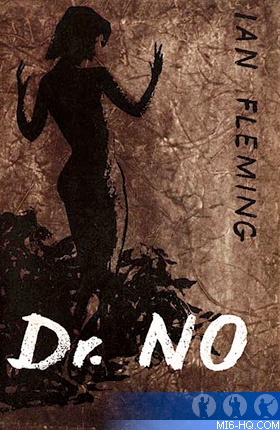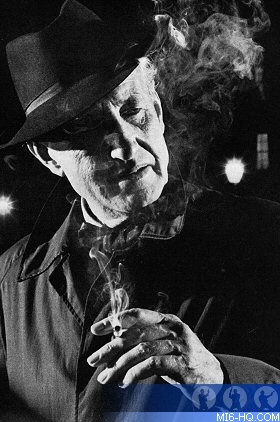 |
| |
50 years since its first publication, MI6 looks back
at Ian Fleming's writing style, inspirations and methods
for constructing his sixth novel, Dr. No... |
|
Fairytales For Grown Ups - The Legacy of Dr
No (1)
31st March 2008
"Dr. No" sees
007 travel to the islands of Jamaica,
still recovering from a poisonous jab from Rosa Klebb, and investigating
the mysterious circumstances surrounding the disappearance of
MI6 agent, Strangways. What was supposed to be a jaunt in the
sun for Bond turns into his most grueling, inhumane assignment
yet. 007 and the young, beautiful Honeychile Ryder have to
fight for their lives as the island of Crab Key unleashes its
darkest threats!
50 years ago this month Ian
Fleming's sixth James Bond novel was unleashed on the British
public. Half a century later, MI6 delves into the back-story,
inspirations and real life scenarios that inspired the classic
007 adventure.
Every Era has a Highlight
Fleming filled his newest work with the style of writing he truly appreciated. The
Bond author often commented that he preferred stories to develop through believable
ideas. He delighted in describing physical things: Bond's gadgets and guns and
the villains' elaborate lairs were just some of his favourites. Fleming believed
in novels he described as having, "started something," or "made
things happen."
"Dr. No" successfully
weaves Fleming's love for the extravagant, with some
well-practiced penmanship and indulges in ideas Fleming
sought, not only
from his imagination, but a trip to the region. It was
in March of 1957 that Fleming was once again faced with
a task of
formulating an idea for his next Bond adventure. During
this period, Fleming was encouraged by his associate
Ivan Bryce
to accompany him on a journey to Great Inagua, a small
southern island in the Bahamas region.
Why exactly Fleming accepted the suggestion
was anyone's guess, but it was here that he encountered
a small village whose income was almost entirely thanks
to
guano - the excretion of tidal birds: flamingos, cormorants,
spoonbills and so on. Guano was a popular substance as
it proved a strong natural fertilizer, easily "harvested" by
a small population for global distribution. The stark,
potent place was an intriguing landscape and starting
point in
Fleming's mind for 007's latest outing - the basis of
which was already brewing in the author's mind. Typically,
Fleming
set about jotting notes and romanticising everything
he described. Another thing that caught his attention
was the harvester's means of transport - described as
swamp-vehicle with giant wheels to overcome the ever-changing
terrain
of the island. It was all but a small stretch of the
imagination
to concoct Dr. No's "dragon". |
|
 Above: The first edition cover
of Dr. No designed by Pat Marriott captures the spirit
of Fleming's rugged island, Crab Key...
Above: The first edition cover
of Dr. No designed by Pat Marriott captures the spirit
of Fleming's rugged island, Crab Key... |
"I do take a lot of my plots from real life. They are certainly bizarre, but they are also made up of real things." - Ian Fleming on finding inspiration
The character of Dr. No himself has often been
rightly likened to the 20th century character, Dr. Fu Manchu
- described as tall, with a brow like Shakespeare and a face
like Satan - the parallel is unmistakable. Fleming was forever
questioned on his inspirations and never more than for the basis
of Dr. No. Fleming once jotted that he preferred the word 'no',
as its easier to say and commits you to far less. The character
of the manic Doctor explains to Bond as they dine that he changed
his named to Julius, after his father, and No for his rejection
of him. The villain of the piece is one of the more
creative of the canon of ever-outrageous scoundrels. The Doctor
is the first of Fleming's villains to devise some sort of test
for 007; both Goldfinger
and Blofeld would echo the concept of testing humanity's stamina,
strength and dedication just as Dr. No's assault course does.
 Above: Ian Fleming defined an
era of spy thrillers and keyed into the national mentality
of the times...
Above: Ian Fleming defined an
era of spy thrillers and keyed into the national mentality
of the times... |
|
The Rhythm of Writing
By the time of writing Dr. No, Fleming was well in the
swing his new lifestyle as an author. This routine of
his, followed strictly to his liking, was precise and
calculated
and
would see him succeeding to churn out a 007 adventure
each year. The structure of the books was unmistakable,
as was Fleming's habitual return to GoldenEye and
his writing habits while in residence. Throughout 1957
and 1958, Fleming would have to live and breath not
one but three of his novels, one that was a mere spark
of imagination.
While promoting "Diamonds
Are Forever", Fleming would at times be editing
his fifth novel, "From
Russia With Love" and researching his sixth.
With a manageable routine and a definite force of habit,
Fleming
was able to concoct extraordinary writing on a very regular
basis.
"Each chapter
is like a wave to be jumped as we race with exhilaration
behind the hero like a water-skier behind a fast motor
boat" - Fleming on writing 007's adventures |
Near Death
Despite the rhythm of 007, by "Dr. No" Fleming may
have been having second thoughts. "From Russia With Love" saw
the hero struck down by the SMERSH operative Klebb in the closing
page of the novel. Nobody is entirely sure if Fleming was in
doubt about continuing his bloody-minded ritual or whether the
cliffhanger can be attributed to good planning and fine marketing
on Fleming's part.
At this time, however, it was clear that Fleming
was growing bored of the daily grind - he particularly despised
the media (although he was originally a journalist himself) and
the tattle of the grimy city, which was London in this era. Whatever
the motive, 007 returned in "Dr. No", a more down-to-earth
character, settled in his ways. James Bond was now someone who
hurt, someone fragile and the characterisation was much stronger
because of it.
Turning Point
Reviewers have discussed "Dr. No" as a critical movement
in the Ian Fleming cannon. He is clearly more comfortable with
the character, with writing as a process and it comes across in
his prose. Critics have highlighted a
parallel to Ian's own turning point in life. In the late 1950s,
Fleming struck out on his own, leaving the world of publishers,
finance
and publicity behind. Bond journeys to the Caribbean, what has
now become a regular haven for his master. Just as Fleming
found the atmosphere constructive to hard work, 007 does not simply
jaunt about the tropics in his newest adventure - he shows emotion,
pain and strong feelings for the women in his life.
Stay tuned to MI6 for the second
part in which the real-life inspirations of "Dr. No" and
the press and fan reaction to Fleming's sixth novel are explored...
Related Articles
 Worlds
Collide - The Legacy of Dr. No (2)
Worlds
Collide - The Legacy of Dr. No (2)
 Ian Fleming
Ian Fleming
 Dr. No
Dr. No
 Literary Articles
Literary Articles